Table Of Content
- Inside the far-right plan to use civil rights law to disrupt the 2024 election
- Civil War
- Arlington House, The Robert E. Lee Memorial
- The Robert E. Lee Memorial
- In Reckoning With Confederate Monuments, Other Countries Could Provide Examples
- Early life and education
- Arlington House, The Robert E. Lee Memorial, Reckons With Its History Of Slavery

What ensued was the Overland Campaign, some seven weeks of brutal, relentless fighting. The armies first met on May 5 and 6, 1864, in the scrubby woods, known locally as the Wilderness, near the old Chancellorsville battlefield. Lee knew his resources were too limited to force Grant back to Washington, D.C., but he had not expected the Union to push onward after its appalling casualties in a stalemated contest at the Battle of the Wilderness. Some of the heaviest fighting of the war took place the following week near Spotsylvania Court House, particularly around a Confederate breastwork known as the Bloody Angle.
Virginia House makes history by nominating first Black speaker - The Washington Post
Virginia House makes history by nominating first Black speaker.
Posted: Sat, 11 Nov 2023 08:00:00 GMT [source]
Inside the far-right plan to use civil rights law to disrupt the 2024 election
In Lee Allred's "East of Appomattox" in Alternate Generals volume 3, Lee is the Confederate Minister to London circa 1868, desperately seeking help for a CSA which has turned out poorly suited to independence. Robert Skimin's Grey Victory features Lee as a supporting character preparing to run for the presidency in 1867. Lee took command of the Army of Northern Virginia in June 1862 during the Peninsula Campaign following the wounding of Joseph E. Johnston. He succeeded in driving the Union Army of the Potomac under George B. McClellan away from the Confederate capital of Richmond during the Seven Days Battles, but he was unable to destroy McClellan's army. Lee then overcame Union forces under John Pope at the Second Battle of Bull Run in August. His invasion of Maryland that September ended with the inconclusive Battle of Antietam, after which he retreated to Virginia.
Civil War
Lee met the court requirements by manumitting the enslaved families of the estate in late 1862. The malaise over slavery followed Lee when he returned to full-time duty in February 1860. As acting head of the Department of Texas he refused to allow that state’s secessionists to wrest federal property from him. As the crisis deepened, however, his thinking became increasingly conflicted. Recalled to Washington, he was promoted in March 1861 to full colonel by the new U.S. president, Abraham Lincoln, and once again swore an oath of allegiance to the United States. A few weeks later, Lee was forced to confront his ambivalence when Virginia seceded and he was offered command of Union forces recruited to protect Washington, D.C.
Arlington House, The Robert E. Lee Memorial
Under Lee’s leadership some of America’s greatest cavalry officers were trained, among them J. Two years later Lee wed Mary Anna Randolph Custis, the witty, artistic great-granddaughter of Martha Washington. He also became increasingly tied to the Custis family seat at Arlington, with its splendid grounds and historical associations. Now dependent on the generosity of their kin, the family moved to Alexandria. Robert attended a relative’s plantation school and the Alexandria Academy, where he was given a classical education. His boyhood was enriched by a supportive and engaging extended family and academic success, but pinched by poverty and his mother’s failing health.
But the Union effort on September 17 was badly executed and its numerical superiority never fully exploited. Lee was able to thwart disaster by adroitly shifting forces to meet each of the violent contests that raged along Antietam Creek. But the arduous march north was poorly outfitted, and the men arrived in Maryland weakened by hunger and diminished by a high rate of desertion and straggling. (By some estimates Lee lost a third of his army.) Greeted without the expected enthusiasm, for the first time they suffered the disadvantage of being on hostile territory. The invasion had been a high-stakes gamble, but Lee increased the odds against him by again dividing his army, despite his officers’ skepticism.
Now, after a year of racial reckoning in the wake of the murder of George Floyd, the county is in the process of redesigning its logo to remove the mansion's image. Thank you for visiting the Office of Army Cemeteries (OAC) network of websites, including mobile applications (apps) and viewing our Privacy Statement. Our network, websites and apps are information systems (IS) provided to you as a public service and managed by the United States Government. By accessing our IS (including any device connected to this IS) you are consenting to the terms and conditions found in our User Acceptance Policy. However, for several years after Congress enacted the authorizing legislation, the War Department, which was responsible for managing the house and grounds, largely ignored the legislation.
Early life and education
E. B. Stuart, who along with Lee were critical to the Confederacy's battlefield success.[1][2] In spite of his successes, his two major strategic offensives into Union territory both ended in failure. Lee’s executorship of Arlington House brought his first brush with national attention. The will stipulated that Lee manumit (free) the enslaved families within five years. However, several enslaved people attested that Custis had promised them immediate manumission, upon his death.[3] The controversy revived in 1859 when three enslaved people escaped because of Lee’s increased work demands and his refusal to grant immediate manumission. Lee had the three freedom seekers apprehended and returned to Arlington House. During the period of increasing abolitionist sentiment, the story drew national attention as evidence of Southern slaveholding brutality and the continuation of enslavement for the full five-year period.
Early 1850s: West Point and Texas
Arlington House, The Robert E. Lee Memorial, reopens following major rehabilitation - Arlington House, The Robert E ... - National Park Service
Arlington House, The Robert E. Lee Memorial, reopens following major rehabilitation - Arlington House, The Robert E ....
Posted: Tue, 08 Jun 2021 07:00:00 GMT [source]
On April 20, Lee resigned from the US Army, often explaining in letters, “save in defense of my native State, I have no desire ever again to draw my sword.” [5] Days later he accepted a commission as a Virginia general. Confederate president Jefferson Davis gave him control of the Army of Northern Virginia in 1862. After the war, Lee returned to structural engineering until 1852, when U.S. secretary of war Jefferson Davis appointed him superintendent of West Point. He was a careful steward of the academy, but found little opportunity for innovation. His rigid belief in the virtue of “duty” was not appreciated by the cadets, among whom he was unpopular.
“This is the largest curatorial, or museum project in the history of the parks service,” Aaron Larocca, a park ranger and NPS spokesperson, tells WTOP. The National Park Service (NPS) has reopened the onetime home of Confederate General Robert E. Lee after a major renovation and the addition of new exhibits on the lives of people enslaved there. New exhibits and materials at Arlington House include the enslaved Syphax and Norris families.

Following the Civil War, Lee was famously subdued in his political commentary. Lee’s choice to resign his US Army commission and join the Confederacy became the defining turning point in his life. He transformed from reluctant secessionist to adamant supporter of the Confederate Cause. In December of 1860, he complained to one of his sons about the “course of the ‘Cotton States’” and that he “hope[d] for the preservation of the Union, and I will cling to it to the last.” [4] However, Virginia seceded on April 17, 1861.
The Mansion was restored to the period of George Washington Parke Custis, and no furniture manufactured after 1830 was accepted. Built by Lee's father-in-law G.W.P. Custis in 1803–1818, Arlington House is a Greek Revival style mansion designed by the English architect George Hadfield. According to Norton, the board will address the issue in public session in a meeting this summer after discussing the property owners in closed session May 6.
FALLS CHURCH, Va. — The Virginia mansion where Robert E. Lee once lived that now overlooks Arlington National Cemetery is open to the public again, after a $12 million rehabilitation and reinterpretation that includes an increased emphasis on those who were enslaved there. Started filling up from soldiers dying on battlefields and in hospitals in Union-controlled Alexandria, Virginia. So Meigs seized the opportunity to turn the Lee property into much-needed cemetery space to accommodate the mounting casualties. Meigs went a step further to plant a painful reminder to the Lees, if they ever returned to Arlington, about the carnage the Civil War caused.
The Hot Springs Town Board will meet May 6 at city hall, located at 186 Bridge St. In Nov. 2020, a statue commemorating the Confederate general was stolen outside of the county courthouse in Marshall. "A part of the town is gone that won't be back. It's a total shame. I've worked accidents where people have ran into it, and it's stood the test of time." Northern California was relatively loyal to the Union, which the state had joined in 1850, but there was considerable sympathy for the Confederacy in Southern California. The pro-slavery editor of the Los Angeles Star used the city’s first newspaper as a pulpit to advocate splitting California into free and slave states.

No comments:
Post a Comment